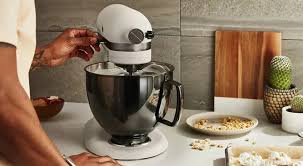If you’ve ever found yourself elbow-deep in cookie dough or spent way too long whipping cream by hand, then a stand mixer might just be the kitchen companion you never knew you needed. This powerhouse appliance has completely transformed home baking and cooking by making prep work faster, easier, and way more enjoyable. Whether you’re a seasoned baker or someone who just loves fresh homemade bread, a stand mixer brings both convenience and consistency to your culinary adventures. It’s not just about mixing—it’s about multitasking, precision, and elevating the quality of everything you makes.
What is a Stand Mixer?
A stand mixer is like the superhero of the kitchen—a powerful, hands-free appliance that makes mixing, kneading, whipping, and even grinding a breeze. Unlike a hand mixer that you have to hold and guide manually, a stand mixer does the job all by itself while you get other things done. With a bowl that locks into place and various attachments that spin on a central hub, it’s ideal for serious home cooks and professional chefs alike.
Benefits of Using a Stand Mixer
One of the biggest perks of using a stand mixer is that it frees up your hands. That means you can prep other ingredients while the mixer does its magic. And let’s not ignore how consistent the results are. Whether you’re whipping egg whites into stiff peaks or kneading pizza dough, it does the job perfectly each time. It also saves loads of time and reduces physical strain, especially when making large batches or working with dense mixtures like bread dough or cookie batter.
Stand Mixer vs Hand Mixer
Let’s clear the air—while hand mixers are great for small tasks, they simply can’t compete with stand mixers in terms of power, stability, and speed. A China Stand mixer can handle thick, sticky doughs without overheating or tiring out your arm. Plus, you can walk away while it works. The stand mixer’s stable base and more powerful motor also mean better mixing, which translates to better texture and flavor in your dishes.
Different Types of Stand Mixers
There’s more than one kind of stand mixer, and choosing the right one can be a game-changer. Tilt-head mixers allow the top to lift back for easy access to the bowl. Bowl-lift mixers, on the other hand, raise and lower the bowl itself and are better for heavier tasks. Then there are commercial-grade mixers, which are bulkier but offer unmatched performance and durability, perfect for high-volume kitchens.
Key Features to Look for in a Stand Mixer
Motor power is a big one—you want a motor strong enough to handle whatever you’re mixing. A 300-watt motor is great for basic needs, but go higher for dense doughs. Bowl capacity matters too; if you often bake for a crowd, a 6-quart bowl is better than a 4.5-quart. Speed settings are important for flexibility. You’ll also want to check what attachments come with the mixer, like dough hooks, flat beaters, and wire whisks. More attachments often mean more versatility.
Popular Stand Mixer Brands
Some names have stood the test of time. KitchenAid is probably the most iconic brand, offering everything from entry-level models to commercial beasts. Cuisinart gives great value for money with powerful motors and sleek designs. Hamilton Beach is your go-to if you’re on a budget but still want reliable performance. Each brand has its pros and cons, but they all offer something for every type of user.
Stand Mixer Attachments and What They Do
The standard trio includes a dough hook, wire whisk, and flat paddle. The dough hook is your best friend for kneading bread or pizza dough. The wire whisk takes care of whipped cream and egg whites. The flat paddle handles most everyday batters and mixtures. Some models go the extra mile with meat grinder, pasta roller, and even ice cream maker attachments—turning your mixer into a full-on kitchen powerhouse.
Choosing the Right Stand Mixer for Your Needs
Ask yourself a few key questions: How often will you use it? What will you make with it? If you’re an occasional baker, a smaller, affordable model might do the trick. But if you’re diving into baking multiple times a week, especially with bread or dense doughs, you’ll want a more powerful and durable mixer. Think about future needs too—are you likely to expand your cooking adventures into homemade pasta or sausages?
Cleaning and Maintaining Your Stand Mixer
Taking care of your mixer is easy but important. Clean the bowl and attachments right after use to avoid hard-to-clean residue. Wipe down the body with a damp cloth—never submerge it. Every now and then, inspect the moving parts for any buildup or wear. With a little regular love, your stand mixer can last for years and perform like new.
Common Mistakes to Avoid
People often overload the bowl, thinking the bigger the batch, the better—but that can strain the motor. Also, not locking the mixer head can cause it to wobble or spill your ingredients everywhere. And using the wrong speed for certain tasks? That’s a recipe for disaster—literally. Always follow your mixer’s instructions and go slow with delicate mixtures.
Budget vs Premium Stand Mixers
You don’t always have to splurge to get quality. Budget mixers are great for casual bakers or beginners. They come with essential features and decent performance. Premium mixers, however, usually offer better motors, more attachments, and long-term reliability. If you bake often or run a small home-based baking business, going premium could actually save you money and time in the long run.
How to Store Your Stand Mixer Properly
If you have the counter space, keep your mixer out—it’s stylish and always ready for action. Otherwise, store it in a lower cabinet but be careful about lifting it—these machines are heavy! Remove attachments and store them separately to avoid damage. Cover the mixer to keep dust away and protect the finish.
Real-World Uses Beyond Baking
Stand mixers aren’t just for cupcakes. With the right attachments, you can roll pasta, grind meat, slice veggies, and even churn out homemade ice cream. It’s like having a sous chef right there with you, ready to take on any culinary challenge you throw its way.
Stand Mixer Safety Tips
Always unplug the mixer before changing attachments or cleaning. Keep fingers and utensils out of the bowl while it’s operating. Make sure the mixer is on a stable surface before use, and don’t walk away for too long—especially at high speeds. Treat it with respect, and it’ll keep your kitchen running smoothly and safely.
Conclusion
A stand mixer isn’t just a fancy kitchen toy—it’s a serious upgrade that brings convenience, efficiency, and joy to your cooking and baking. Whether you’re a weekend baker or a culinary pro, investing in the right stand mixer can transform your kitchen routine. With the ability to whip, knead, grind, and more, it’s the versatile tool you didn’t know you needed—until now.

